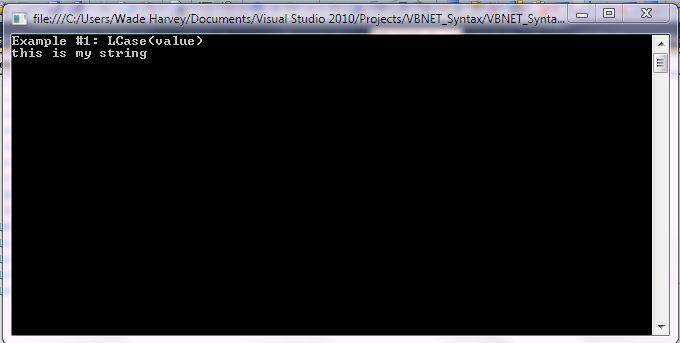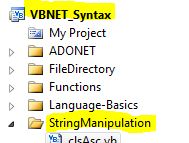VB.NET LCase() – Code Sample
Posted by asp.net videos on Wednesday, February 9, 2011 · Leave a Comment
Premium (Not Free) Video Tutorials
Free Video Tutorials & Free Tools
Premium (Not Free) Video Tutorials
Free Video Tutorials & Free Tools
VB.NET LCase Example – Code Sample Syntax
Abstract: – Illustrates using VB.NET LCase Code Example.
*** 2. LCase Syntax ***
Purpose:
Returns a string or character in lowercase.
Syntax:
LCase(value)
| Parameters |
Description |
value |
Required – string to be converted to lowercase
|
| Result Data Type |
Description |
string |
Returns a string or character in lowercase.
|
*** 3. LCase – Quick Example ***
|
Dim strField As String = “This Is my string”
Console.WriteLine(LCase(strField)) ‘Returns this is my string
|
*** 4. LCase – Full Example ***
LCase Example Output Screenshot

Step 1: Click Visual Basic to Cut-n-paste code into clsLCase.vb
Public Class clsLCase
Public Sub Main()
'****************************************************************************************
' Purpose: Returns a string or character in lowercase.
'
' Syntax: LCase(value)
'
' Parameter1: value - Required - string to be converted to lowercase
'
' Result: string - Returns a string or character in lowercase.
'
' Quick Example: Dim strField As String = "This Is my string"
' Console.WriteLine(LCase(strField)) 'Returns this is my string
'
'****************************************************************************************
Console.WriteLine("Example #1: LCase(value) ")
Dim strField As String = "This Is my string"
Console.WriteLine(LCase(strField)) 'Returns this is my string
'write blank line to make output easier to read
Console.WriteLine()
'Prevent console from closing before you press enter
Console.ReadLine()
End Sub
End Class |
Public Class clsLCase
Public Sub Main()
'****************************************************************************************
' Purpose: Returns a string or character in lowercase.
'
' Syntax: LCase(value)
'
' Parameter1: value - Required - string to be converted to lowercase
'
' Result: string - Returns a string or character in lowercase.
'
' Quick Example: Dim strField As String = "This Is my string"
' Console.WriteLine(LCase(strField)) 'Returns this is my string
'
'****************************************************************************************
Console.WriteLine("Example #1: LCase(value) ")
Dim strField As String = "This Is my string"
Console.WriteLine(LCase(strField)) 'Returns this is my string
'write blank line to make output easier to read
Console.WriteLine()
'Prevent console from closing before you press enter
Console.ReadLine()
End Sub
End Class Step 2: Click Visual Basic to Cut-n-paste code into Module1.vb
Module Module1
Sub Main()
Dim myclsLCase As New clsLCase
myclsLCase.Main()
End Sub
End Module |
Module Module1
Sub Main()
Dim myclsLCase As New clsLCase
myclsLCase.Main()
End Sub
End Module Prerequistes:
- Install Visual Basic (Express or Standard Edition)
- Install SQL Server Express
- Download Northwind and pubs Database
- Attach Northwind Database to Databases in Sql Express
- Attach pubs Database to Databases in Sql Express
Notes:
- Console Application is used to simplify things, but Windows Forms or Web Forms could also be used
- You can build a library of syntax examples by using same project over and over and just commenting out what you do not want to execute in Module1.vb
Instructions:

- Use Visual Basic 2010 Express or Standard Edition
- Create new project;
- Click File/New Project
- Select Console Application Template
- Select Visual Basic for Language
- name of project could be VBNET_Syntax.
- Add New folder named “StringManipulation”
- Right-click project name in solution explorer;
- add new folder;
- name of folder could be: StringManipulation
- Add Class Named clsLCase to StringManipulation folder
- Right-click StringManipulation folder;
- add new item;
- Select class
- Class name could be clsLCase
- Click on Visual Basic in code in step 1 above to copy code into clsLCase.vb
- Click on Visual Basic in code in step 2 above to copy code into Module1.vb
- Click green arrow or press F5 to run program
|
 Download Source Code for All VB Console Examples in One Project
Download Source Code for All VB Console Examples in One Project
